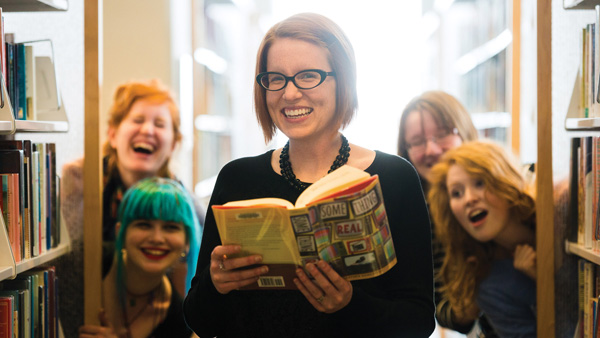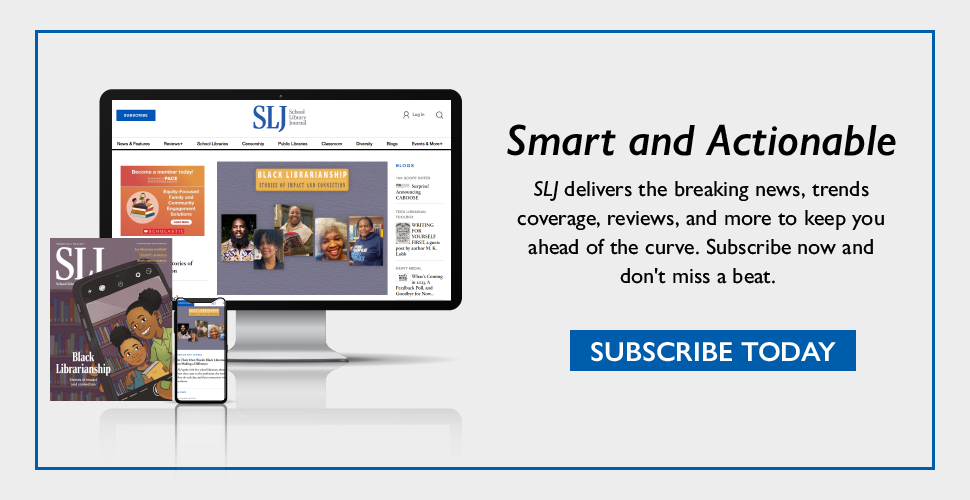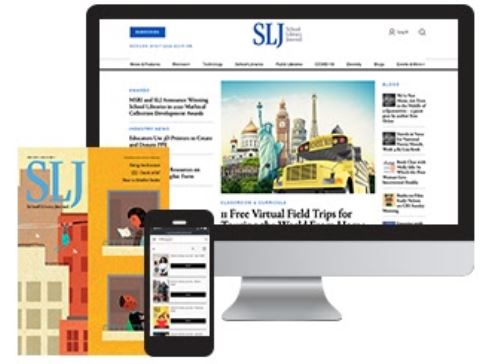LGBTQ & You: How to Support Your Students

Photograph by Kai Teoh/Ink Café Photography
A former part-time school library assistant, Amanda MacGregor (above) considers the lesbian, gay, bisexual, transgender, and questioning (LGBTQ) teens she worked with for more than three years to be “my kids,” she says. Wanting to make sure materials were available for them—without forcing students to request them directly—MacGregor created displays of LGBTQ books, listed phone numbers for groups like the Trevor Project, a crisis intervention program for LGBTQ young people, and mixed LGBTQ titles in with ones thematically ranging from vampire tales to mysteries when creating book lists.
However, she thinks that her mere presence in a room without doors or an office, where students who needed a safe space could walk in and just be themselves, may have been her greatest value.
“Kids in general are often so grateful to have someone show an interest in their lives and accept them for who they are,” she says. “I had one kid in my first year who spent a fair amount of time talking with me, often about having crushes on boys. He sent me a private message last year saying, ‘I never thanked you for encouraging me to be myself.’ That means something to me, even three years later.”
The library: An unofficial refuge
Quick Tips
Online sites are often the first go-to resources for educators searching for book lists and tips on setting up their libraries with more LGBTQ materials. Where do librarians look?
Kyle Lukoff often heads to Tumblr to find “some 21-year-old gender queer” whom he then follows. He learns a lot by just reading the comments—but is careful to not chime in himself. “Flame wars aren’t great to participate in,” he says.
Sarah Stone suggests going to the American Library Association’s (ALA) site to look at current-year winners of Stonewall Book Awards.
Amanda MacGregor herself blogs at Cite Something! and writes about LGBTQ resources, GLSEN’s National School Climate Survey, and other topics.
Jillian McCoy turns to sites including the Trevor Project, the Gay-Straight Alliance Network, and Lamba Legal, a resource site focusing on the legal rights of lesbians, gay men, bisexuals, transgender people, and those living with HIV.
GLSEN’s Jenny Betz recommends librarians look at the ALA Gay, Lesbian, Bisexual, and Transgender Round Table (GLBTRT) Rainbow List for suggested titles, while also reading through GLBTRT’s site for resources for GLBTQ-identifying librarians.
GLSEN produces a “Tools for Librarians” sheet, a two-page poster stocked with instructions on creating a Safe Space Kit, including one aimed at elementary schools. PDFs of the poster can be requested by email.
With 82 percent of LGBTQ students reporting verbal harassment, among other forms of bullying, according to the Gay, Lesbian & Straight Education Network’s (GLSEN) 2011 School Climate Report, finding a space to feel safe may be particularly crucial for these students. So is finding materials in which LGBTQ students can see themselves—resources that reflect the stories of their lives and the themes that mirror their own questions and concerns. School librarians provide support through their very presence as well as through the services they can provide.
“I remember hiding out in the library to escape bullying or because I generally felt I was not fitting in,” says Jenny Betz, senior education manager for GLSEN. “It gave me a place to be.”
GLSEN has seen library use grow among students seeking LGBTQ-specific content and information. This is no surprise, says Betz, since librarians are free-speech supporters and usually want to ensure LGBTQ student access to materials.
School librarians can highlight titles without making “a big deal, or doing things that might out people, by just leaving books on the tables, on the fly,” Betz says. “Librarians have been doing this for generations, really finding ways to serve their constituents.”
And LGBTQ teens are a constituency that librarians and educators consistently report as needing to be served.
More than 38 percent of LGBTQ teens report physical harassment, and 18.3 percent report being physically assaulted because of their sexual orientation, according to GLSEN’s 2011 School Climate Report (a 2013 report is due this fall). The Web can also be an unsafe space for LGBTQ youth, with 42 percent reporting being harassed or bullied online—three times more than non-LGBTQ youth—and 27 percent saying they feel unsafe online, according to GLSEN’s “Out Online” report from 2013.
L. Lee Butler, a librarian at the Stoughton (MA) High School, agrees that a librarian can play a key role in a student’s school life as a “trusted adult who is not part of the evaluating or disciplinary process,” he says. “That’s not to say we don’t discipline students or evaluate their work. But we are not giving them a grade. We can be more approachable than many classroom teachers.”
Butler focuses in particular on making sure his students have access to “accurate and age-appropriate sexual health information,” he says. While he makes sure he has materials available, he also watches to see which titles are never returned. Books that mention anything about sex? They often go missing, he says.
“They’re not just being checked out voraciously. They just disappear off the shelves,” he says. “The books that are stolen are often the ones most needed in your collection.”
To highlight the books he thinks are important, Butler simply puts up displays on topics about sexual health and education when the Gay Straight Alliance comes in for their regular meetings. While “hanging out” near the check-out area afterwards, Butler says, they discover the titles he has purposefully, but casually, placed there.
“They’re seniors, so they won’t admit they need the information. But they do,” he says. “They say they’re going to give the resources to their classmates. They become information vectors.”
Finding LGBTQ content for teens
Students, particularly those in their teen and tween years, also say they want to see more genres featuring LGBTQ students as characters, even if gender orientation isn’t the main plot point.
When school librarian Jillian McCoy started at the Academy of Mount St. Ursula school in the Bronx, the ninth-through-twelfth grade girls started requesting “books that weren’t just coming-out stories, but with LGBTQ characters in them,” she says. “They were pretty vocal about it.” At first, McCoy had trouble finding some genres, such as fantasy, with LGBTQ characters. But that’s starting to change, she says.
Elementary school librarians may not have as many questions regarding LGBTQ issues as their high school counterparts, but they still have a responsibility to serve their students with these materials, believes Kyle Lukoff, a librarian at Corlears School in Manhattan. Lukoff actively searches for titles with LGBTQ themes for his younger students.
“I don’t have Suzanne Collins’s The Hunger Games (Scholastic, 2008) in my library,” says Lukoff. “But I have Jennifer Carr’s Be Who You Are! (AuthorHouse, 2010), which is about trans kids. It’s a matter of finding the materials.”
Lukoff has heard the arguments that children, particularly those in the younger grades, might get confused by reading material adults don’t believe they can understand, such as gender orientation. But he finds that argument specious. “Kids are always confused,” he says. “They’re confused about why their hands are sticky, or about what makes their jacket fall off their desk. Math is confusing. And we don’t say not to teach them math.”
Sarah Stone believes that her patrons should have access to as many materials as she can find and stock at the San Francisco Public Library, where she serves as a branch collections specialist. Stone is especially attuned to including LGBTQ-relevant titles. “There is a sense of showing some leadership because we are San Francisco,” she says. “If it touches on some aspect of LGBTQ life, we probably want that book unless it is terrible.”
Stone turns to blogs, traditional channels such as ALA’s Stonewall Book Awards, and sites such as Goodreads to find new titles. Waiting for a review copy is the last way Stone wants to discover a book. Instead, she says, librarians “can be on the prowl.”
That means looking at books focusing on LGBTQ issues from many different angles, says Stone. She mentions Chris Terry’s Zero Fade (Curbside Splendor, 2013), about a teen named Kevin Phifer whose uncle comes out as gay.
However, “the queer experience doesn’t have to be limited to ‘coming out’ books,” Stone says. “It can be dealing with your own homophobia.”
Or, a title can be a book that simply features an LGBTQ family within its story line. As many as six million American children and adults have an LGBTQ parent, according to the UCLA School of Law’s Williams Institute.
“There are children in the classroom whose families look like that,” says April Sanders, assistant professor at Spring Hill College’s Division of Teacher Education in Mobile, AL. “These books point to the importance of students finding themselves in the literature.”
Sanders, who works with students pursuing teaching degrees, regularly emphasizes that LGBTQ books need to be part of collections, and displayed prominently—in classrooms as well as school media centers. Students don’t always get time to go to the library, she notes.
“I can’t emphasize enough how important is it for our students to be seeing themselves in the reading,” says Sanders. “I think that goes a long way for students who are particularly dealing with issues like bullying.”
Librarians who are unsure of how to launch a book collection or build other materials for LGBTQ students should take the advice they give to students, says Saunders.
“Sometimes it’s just getting out there,” she says. And “sometimes we just need to take a breath, and read some books.”
Outstanding Titles
Four librarians weigh in on essential LGBTQ books
L. Lee Butler
And Tango Makes Three by Justin Richardson and Peter Parnell, illustrated by Henry Cole (S. & S., 2005). PreS-Gr 2. Two male penguins and their baby.
Sex, a Book for Teens: An Uncensored Guide to Your Body, Sex, and Safety by Nikol Hasler (Zest, 2010). Gr 10 Up. “General sex ed and sexuality, including a lot about LGBTQ teen experiences.”
Kyle Lukoff
Be Who You Are! by Jennifer Carr (AuthorHouse, 2010). Gr 3-5. “About trans kids, written for younger kids.”
Gender Outlaws: The Next Generation edited by Kate Bornstein and S. Bear Bergman (Seal Pr., 2010). An adult publication appropriate for teens. “Provides a lot of different perspectives about gender.”
What Makes a Baby by Cory Silverberg, illustrated by Fiona Smyth (Triangle Square, 2013). PreS-Gr 2. A book about where babies come from that doesn’t specify parents’ gender or sexuality.
April Sanders
Daddy, Papa, and Me by Lesléa Newman (Tricycle, board book edition, 2009). PreS. “Board book for a very young level.”
Sarah Stone
Beautiful Music for Ugly Children by Kirstin Cronn-Mills (Flux, 2012). Gr 7 Up. “Includes a transgender character.”
Better Nate Than Ever by Tim Federle (S. & S., 2014). Gr 4-8. A 13-year-old boy heads to the Big Apple looking to audition for a big-city musical.
The Miseducation of Cameron Post by emily m. danforth (HarperCollins, 2012). Gr 8 Up. Teen coming-of-age book.
10,000 Dresses by Marcus Ewert, illustrated by Rex Ray (Triangle Square, 2008). K-Gr 4. A picture book about a child who dreams at night of dresses.
Violet in Bloom: A Flower Power Book by Lauren Myracle (Abrams, 2010). Gr 4-8. “Has character with two moms, an experience that some readers may have in common.”
Zero Fade by Chris L. Terry (Curbside Splendor, 2013). Gr 5 Up. The main character struggles with homophobic feelings about his uncle, who is coming out.
Add Comment :-
RELATED
The job outlook in 2030: Librarians will be in demand
The job outlook in 2030: Librarians will be in demand
ALREADY A SUBSCRIBER? LOG IN
We are currently offering this content for free. Sign up now to activate your personal profile, where you can save articles for future viewing






